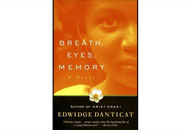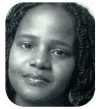Breath, Eyes, Memory
Announced May 22, 1998

At an astonishingly young age, Edwidge Danticat has become a writer who evokes the wonder, terror, and heartache of her native Haiti—and the enduring strength of Haiti's women—with a vibrant imagery and narrative grace that bear witness to her people's suffering and courage.
About the BookSet in the island's impoverished villages and in New York's Haitian community, this is the story of Sophie Caco, who was conceived in an act of violence, abandoned by her mother and then summoned to America. In New York, Sophie discovers that Haiti imposes harsh rules on its own.
At the age of twelve, Sophie Caco is sent from her impoverished village of Croix-des-Rosets to New York, to be reunited with a mother she barely remembers. There she discovers secrets that no child should ever know and a legacy of shame that can be healed only when she returns to Haiti—to the women who first reared her. What ensues is a passionate journey through a landscape charged with the supernatural and scarred by political violence, in a novel that bears witness to the traditions, suffering, and wisdom of an entire people.
More on Breath, Eyes, Memory
Also from Edwidge Danticat
- How a stranger's gift during a visit to Haiti reminds the author of her childhood inspiration
- O, The Oprah Magazine's reviews of one of Danticat's latest novels, Brother, I'm Dying
- Edwidge Danticat's Aha! moment

About the Author
Edwidge Danticat was born in Haiti in 1969 and raised by her aunt. She was reunited with her parents in the U.S. at age 12. She published her first writings two years later.
Danticat holds a degree in French literature from Barnard College and an MFA from Brown University. Her short stories have appeared in over 20 periodicals, and she has won awards from Seventeen magazine and from Essence, as well as a James Michener Fellowship, and was named a 2009 MacArthur Fellow. She is also the author of a short-story collection, Krik? Krak!
Read O, The Oprah Magazine's review of one of Danticat's latest novels, Brother, I'm Dying.
Edwidge Danticat was born in Haiti in 1969 and raised by her aunt. She was reunited with her parents in the U.S. at age 12. She published her first writings two years later.
Danticat holds a degree in French literature from Barnard College and an MFA from Brown University. Her short stories have appeared in over 20 periodicals, and she has won awards from Seventeen magazine and from Essence, as well as a James Michener Fellowship, and was named a 2009 MacArthur Fellow. She is also the author of a short-story collection, Krik? Krak!
Read O, The Oprah Magazine's review of one of Danticat's latest novels, Brother, I'm Dying.
Reading Group Discussion Questions
View printable version
The questions, discussion topics, author biography, and suggested reading that follow are designed to enhance your group's reading of Edwidge Danticat's Breath, Eyes, Memory. We hope they will bring to life the many themes with which Danticat builds her story of a young Haitian woman's coming to terms with her country, her mother, and her own identity.
View printable version
The questions, discussion topics, author biography, and suggested reading that follow are designed to enhance your group's reading of Edwidge Danticat's Breath, Eyes, Memory. We hope they will bring to life the many themes with which Danticat builds her story of a young Haitian woman's coming to terms with her country, her mother, and her own identity.
-
Edwidge Danticat has said that in Haiti, "Everything is a story. Everything is a metaphor or a proverb." How does the character of grandmother personify this tendency? How do some of the proverbs and tales she tells Sophie relate to the events and themes of the novel?
-
As a young girl, Martine's favorite color was daffodil yellow; in middle age, she is obsessed with the color red. What significance and associations do these colors have for her? In what way does the change from yellow to red symbolize the change in Martine's own character? Does Danticat use color symbolically elsewhere in the story?
-
Martine once hoped to be a doctor; later, she transfers her ambitions to Sophie. "If you make something of yourself in life," she says to her daughter, "we will all succeed. You can raise our heads." (p. 44) Why does Sophie consciously reject her mother's ideal of high achievement? Why does she choose to become a secretary rather than, for instance, a doctor?
-
Atie says to Sophie, "Your mother and I, when we were children we had no control over anything. Not even this body" (p. 20). How does this knowledge help Sophie shape her life? In what ways does Sophie take control of her own life as her mother and aunt never were able to?
-
Atie says to Sophie, "Your mother and I, when we were children we had no control over anything. Not even this body" (p. 20). How does this knowledge help Sophie shape her life? In what ways does Sophie take control of her own life as her mother and aunt never were able to?
-
In the graveyard, Atie reminds Sophie to walk straight, since she is in the presence of family. Grandmother If® plans carefully for her death, which she thinks of as a "journey." (p. 195) How do Haitian attitudes toward death and the dead, as illustrated in this novel, compare with American ones? How does each culture attempt to foster a sense of wholeness, of continuity, between the generations?
-
Sophie feels that Haitians in America have a bad image as "boat people" and "stinking Haitians." Are her efforts to assimilate, to become "American," in any way related to her physical self-loathing ("I hate my body. I am ashamed to show it to anybody, including my husband?" (p. 123]) How does her bulimia express such self-loathing?
-
Breath, Eyes, Memory is primarily a story of the relationships between women: mothers, daughters, grandmothers, sisters. But there are two significant male characters in the novel, Joseph and Marc. Does Danticat depict Joseph and Marc as full, rounded-out characters, or do we see them only through Sophie's slanted point of view? How does Sophie express her ambivalent feelings about both of them? Why is she so angry with Marc after her mother's death? Do you feel that her anger is justified? Is it possible that Sophie's aloofness from both these men stems from her upbringing in an almost exclusively female world, where "men were as mysterious to me as white people?" (p. 67)
-
The Haitian goddess Erzulie is both a goddess of love and the Virgin Mary. What does this tell you about the Haitian culture and its ideas of love and religion? How does this differ from American and European culture?
-
Martine's rape by an unknown man, possibly a Macoute, is the defining event in her life, bringing with it overpowering feelings of fear and self-loathing which she passes on to her daughter. Sophie's therapist even suggests that Martine undergo an exorcism. How does Sophie in her own way succeed in "exorcising" the evil events of the past? "It was up to me to avoid my turn in the fire" (p. 203), she says; how does she achieve this?
-
When Sophie breaks her maidenhead with the pestle, she likens it to "breaking manacles, an act of freedom" (p. 130). What exactly does "freedom" mean to Sophie? Which of her other actions represent bids for freedom and autonomy? What does she accomplish when, at the end of the novel, she beats the stalks of sugar cane? What does the final cry of "Ou lib®r®" (p. 233) mean to Sophie? To Atie? Do you feel that Martine in some manner "liberated" herself by committing suicide? Or was her act one of submission?
-
Do you believe that the three women in the sexual phobia group have comparable problems? Is the word "abuse" equally appropriate in each of their cases? How effective is their joint attempt to free themselves from their past? Is Buki's wrecked balloon a pessimistic symbol? Do you believe that the therapist's psychological tools are adequate to deal with the complex, culturally rooted problems of Sophie and Buki?
-
When a new baby is born in Haiti, says If®, "if it is a boy, the lantern will be put outside the shack," but if it is a girl "only the mother will be left in the darkness to hold her child. There will be no lamps, no candles, no more light." (p. 146) How does this ritual, with its sense of sorrow rather than celebration, color Martine's feelings for Sophie, and Sophie's for Brigitte?
-
What is the significance of Martine's "Marassas" story in the context of the relationship between Martine and Sophie? Why does Martine tell the story to Sophie as if she is "testing" her? Why is the theme of likeness, of identification between mother and daughter, so important to Martine? Why does Sophie resist it? When she comes to terms with her mother at the end of the novel, is it because she identifies with her mother or because she comes to feel independent of her? Or both? Do you sense that she has fully forgiven Martine for the hurt she has caused her?
-
Violence and fear are important elements of this story. How does Danticat highlight the family's personal sense of violence with carefully chosen incidents of random violence in Haitian society? From the way Danticat describes rural Haiti, does violence seem an intrinsic element of the culture or does it instead seem something imposed from outside?

Book Reviews
"Danticat's calm clarity of vision takes on the resonance of folk art... Extraordinarily successful."
—The New York Times Book Review
"A novel that rewards the reader again and again with small but exquisite and unforgettable epiphanies."
— Bob Shacochis, Washington Post Book World
"Written in prose as clear as a bell, magical as a butterfly, and resonant as drum talk... An impressive debut."
— Julia Alvarez, author of How the Garcia Girls Lost Their Accents
"A wise child's exploration — sensual, moving, clear-sighted."
—Kelvin Christopher James, author of Secrets
"An eloquent tale of four Haitian women and the sometimes anguished ties that bind them... and impressive first novel."
—Mirabella
"Her story gives voice, depth and anguish to the loving, bittersweet ties that bind her to her circle of women. Breath, Eyes, Memory paints a rich portrait of a lush countryside, cane fields, rainwater baths... [and] illuminates the beauty and family life of Haiti."
—Boston Globe
"Danticat's calm clarity of vision takes on the resonance of folk art... Extraordinarily successful."
—The New York Times Book Review
"A novel that rewards the reader again and again with small but exquisite and unforgettable epiphanies."
— Bob Shacochis, Washington Post Book World
"Written in prose as clear as a bell, magical as a butterfly, and resonant as drum talk... An impressive debut."
— Julia Alvarez, author of How the Garcia Girls Lost Their Accents
"A wise child's exploration — sensual, moving, clear-sighted."
—Kelvin Christopher James, author of Secrets
"An eloquent tale of four Haitian women and the sometimes anguished ties that bind them... and impressive first novel."
—Mirabella
"Her story gives voice, depth and anguish to the loving, bittersweet ties that bind her to her circle of women. Breath, Eyes, Memory paints a rich portrait of a lush countryside, cane fields, rainwater baths... [and] illuminates the beauty and family life of Haiti."
—Boston Globe



